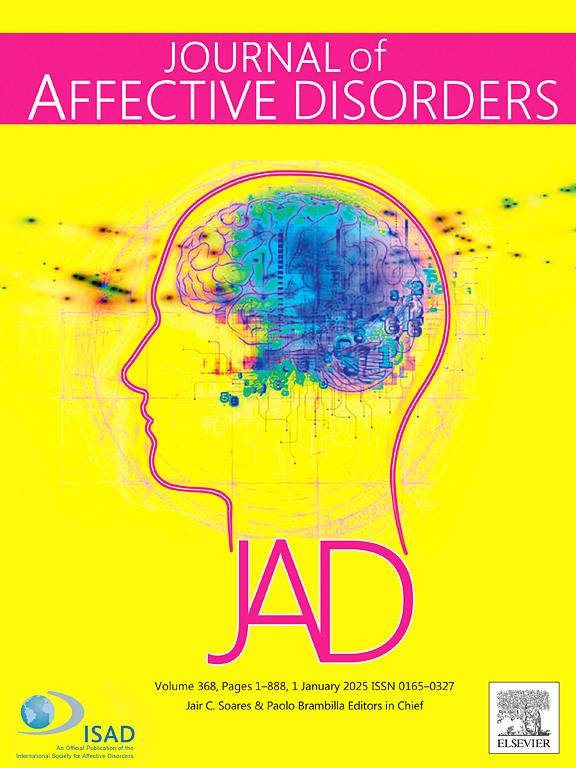亲密伴侣暴力的瞬间动态和女性创伤后应激症状:积极情绪失调的影响。
IF 4.9
2区 医学
Q1 CLINICAL NEUROLOGY
引用次数: 0
摘要
目的:在遭受亲密伴侣暴力(IPV)的妇女中,创伤后应激症状(PTSS)是一个主要的公共卫生负担。然而,有必要更好地了解IPV和PTSS随着时间的推移是如何联系在一起的。一个未被充分研究的因素可能影响ipvv - ptss关联是由积极情绪引起的失调。本研究的目的是阐明IPV类型(心理、生理、性)与创伤后应激障碍之间的时间动态关系,以及积极情绪失调的影响。方法:参与者是从社区招募的145名女性(法师 = 40.66 %,白人40.7 %),经历过IPV并使用任何数量的酒精或药物,完成了基线疗程和每日三次调查,持续30 天。进行了多级动力结构方程建模分析。结果:在人内水平上,IPV对心理(标准化固定效应估计 = 0.27,95 % CI[0.02, 0.61])和身体(标准化固定效应估计 = 0.61,95 % CI[0.22, 1.14]) IPV预测下一间隔PTSS存在显著的交叉滞后效应,但对性IPV不存在。在人际水平上,基线积极情绪失调与IPV的随机交叉滞后效应和性IPV的下一间隔PTSS显著相关(标准化固定效应估计 = 0.29,95 % CI[0.02, 0.52]),但与心理或生理IPV无关。结论:研究结果揭示了各种类型的IPV如何在经历IPV和使用物质的女性的日常生活经历中使ptsd持续存在,并强调了积极情绪失调的重要影响。本文章由计算机程序翻译,如有差异,请以英文原文为准。
Momentary dynamics of intimate partner violence and posttraumatic stress symptoms among women: The influence of positive emotion dysregulation
Objective
Posttraumatic stress symptoms (PTSS) among women experiencing intimate partner violence (IPV) are a major public health burden. Yet, there is a need to better understand how IPV and PTSS relate over time. One understudied factor that may influence the IPV-PTSS association is dysregulation stemming from positive emotions. The objective of the current study was to clarify the temporal dynamics between IPV types (psychological, physical, sexual) and PTSS as well as the influence of positive emotion dysregulation.
Methods
Participants were 145 women recruited from the community (Mage = 40.66, 40.7 % white) experiencing IPV and using any amount of alcohol or drugs who completed a baseline session and three daily surveys for 30 days. A multi-level dynamic structural equation modeling analysis was tested.
Results
At the within-person level, significant cross-lagged effects were found for IPV predicting next-interval PTSS for psychological (Standardized Fixed Effect Estimate = 0.27, 95 % CI[0.02, 0.61]) and physical (Standardized Fixed Effect Estimate = 0.61, 95 % CI[0.22, 1.14]) IPV, but not sexual IPV. At the between-person level, baseline positive emotion dysregulation was significantly associated with the random cross-lagged effect for IPV and next-interval PTSS for sexual IPV (Standardized Fixed Effect Estimate = 0.29, 95 % CI[0.02, 0.52]), but not psychological or physical IPV.
Conclusion
Findings shed light on how IPV across types perpetuates PTSS in the daily lived experiences of women who experience IPV and use substances and underscore a significant influence of positive emotion dysregulation.
求助全文
通过发布文献求助,成功后即可免费获取论文全文。
去求助
来源期刊

Journal of affective disorders
医学-精神病学
CiteScore
10.90
自引率
6.10%
发文量
1319
审稿时长
9.3 weeks
期刊介绍:
The Journal of Affective Disorders publishes papers concerned with affective disorders in the widest sense: depression, mania, mood spectrum, emotions and personality, anxiety and stress. It is interdisciplinary and aims to bring together different approaches for a diverse readership. Top quality papers will be accepted dealing with any aspect of affective disorders, including neuroimaging, cognitive neurosciences, genetics, molecular biology, experimental and clinical neurosciences, pharmacology, neuroimmunoendocrinology, intervention and treatment trials.
 求助内容:
求助内容: 应助结果提醒方式:
应助结果提醒方式:


